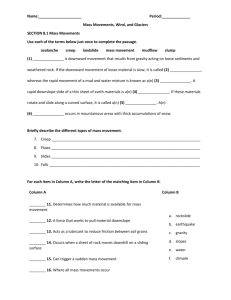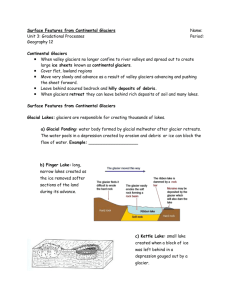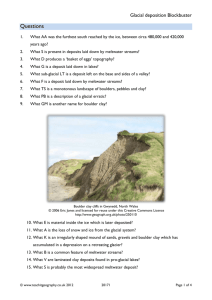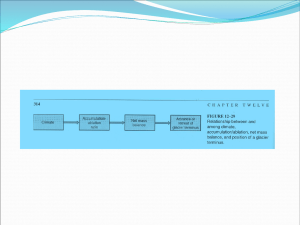Glaciation - Geo
advertisement
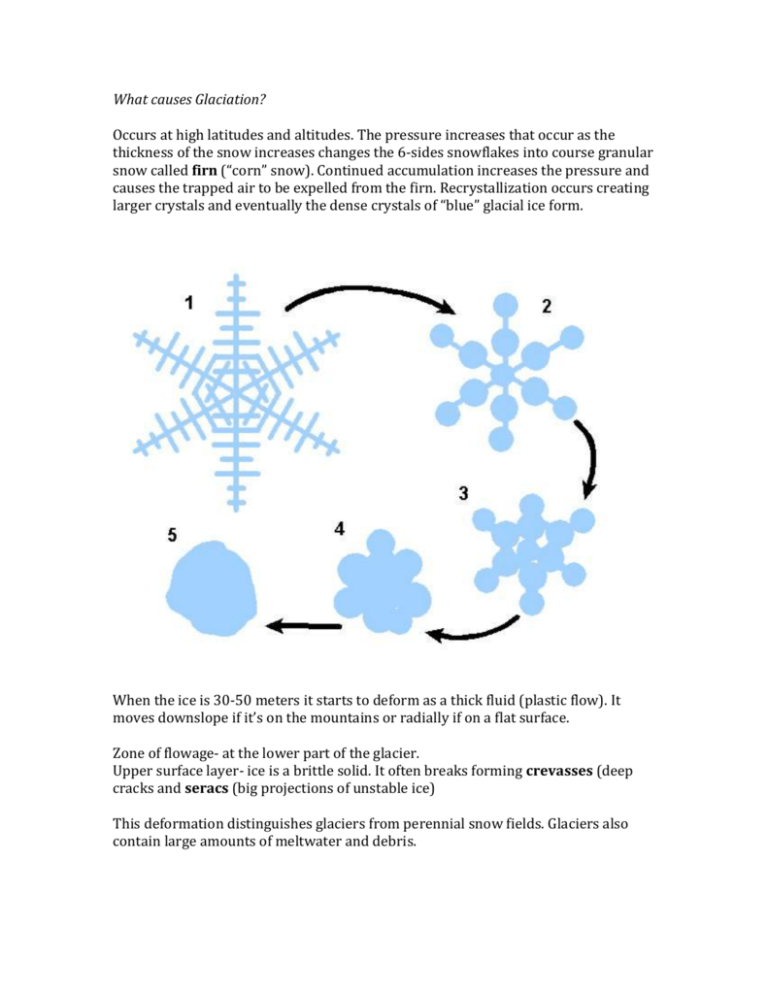
What causes Glaciation? Occurs at high latitudes and altitudes. The pressure increases that occur as the thickness of the snow increases changes the 6-sides snowflakes into course granular snow called firn (“corn” snow). Continued accumulation increases the pressure and causes the trapped air to be expelled from the firn. Recrystallization occurs creating larger crystals and eventually the dense crystals of “blue” glacial ice form. When the ice is 30-50 meters it starts to deform as a thick fluid (plastic flow). It moves downslope if it’s on the mountains or radially if on a flat surface. Zone of flowage- at the lower part of the glacier. Upper surface layer- ice is a brittle solid. It often breaks forming crevasses (deep cracks and seracs (big projections of unstable ice) This deformation distinguishes glaciers from perennial snow fields. Glaciers also contain large amounts of meltwater and debris. Glacial Deposits Glacial drift: sediments of glacial origin that are distinguished by mechanically weathered rock debris that underwent little or no chemical weathering prior to deposition (i.e. hornblende, plagioclase feldspars). Two types of glacial drift are till- materials deposited directly by the glacier and stratified drift- sediments laid down by glacial meltwater Landforms made of Till These deposits can be distinguished by unsorted mixtures of rock material. Many pieces are striated and polished. Glacial erratics are boulders found in the till or lying free on the surface. End (terminal) moraine- a ridge of till that forms at the ends of ice sheets and valley glaciers. It forms when the ice is melting and evaporating near the end of a glacier at a rate equal to the forward advance of the glacier from its region of nourishment. The terminus of the glacier is stationary (Think of a conveyer belt). Ground (recessional) moraine-this occurs when equilibrium does not exist and melting exceeds nourishment. The glacier then recedes in direction and provides fresh supplies of till, creating a rock-strewn, undulating plain. Lateral moraine- when ice erodes the sides of the valley, and large quantities of debris are added to the glacier’s surface, which collects on the edges of moving ice. Medial Moraine- these are created when two glaciers join and the till that was on the outside joins to form a single dark strip of debris in the newly enlarged glacier. Drumlins- occurs when glaciers advance over previously deposited drift and reshape the material. They form asymmetrical hills occurring in clusters Stratified Drift Stratified drift is sorted according to size and weight of particles from glacial meltwater (usually sand and gravel). When an end moraine is forming, the melting glacier can cascade over the till. Meltwater gradually emerges from ice in rapidly moving streams carrying a big load. Therefore the debris is dropped and water creates braided channels. When this is formed with an ice sheet it is called an outwash plain. When it is confined to a mountain valley it is called a valley train. They often have depressions called kettles, which are from chunks of ice buried in drift creating pits. Ice contact deposits-The formation of hills terraces and ridges when a glacier shrinks and flow stops. The meltwater that flows over, within and at the base lays down these deposits. Kame- a steep hill eskers- long narrow ridges






